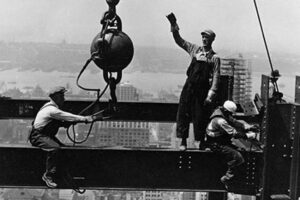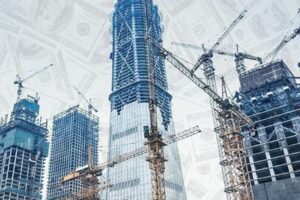Skyscrapers are some of the most iconic structures in the world. They are a testament to human ingenuity and engineering prowess. However, the construction of skyscrapers has not been without its risks. Many workers have died or been injured during the construction of these massive buildings.
The exact number of people who have died building skyscrapers is not known. However, it is estimated that hundreds of workers have lost their lives during the construction of some of the world’s tallest buildings. For example, at least 38 workers died during the construction of the Empire State Building in New York City. And at least 63 workers died during the construction of the World Trade Center towers.
The dangers of skyscraper construction are manifold. Workers must often work at great heights, and they are exposed to the elements and to the risk of falling objects. They also work with heavy machinery and equipment, which can be hazardous. In addition, skyscraper construction often takes place in densely populated areas, which can increase the risk of accidents.
1. Height
Height is a major factor in the number of deaths that have occurred during skyscraper construction. Workers must often work at great heights, exposed to the elements and the risk of falling. The higher the building, the greater the risk of accidents. This is because falls from greater heights are more likely to be fatal. In addition, high winds can make working conditions treacherous, and workers may be more likely to be injured or killed by falling objects at greater heights.
For example, during the construction of the Empire State Building, at least 38 workers died. Many of these deaths were caused by falls from great heights. In one incident, five workers were killed when a scaffold collapsed on the 86th floor. In another incident, a worker was killed when he fell from the 102nd floor.
The height of skyscrapers has also led to the development of new safety measures. For example, many skyscrapers now have safety nets that can catch workers who fall. In addition, workers often wear safety harnesses that can prevent them from falling in the first place. These measures have helped to reduce the number of deaths that occur during skyscraper construction.
2. Equipment
The equipment used in skyscraper construction has a major impact on the number of deaths that occur. Heavy machinery and tools can be hazardous, and workers can be injured or killed if they are not properly trained to use them. In addition, equipment failures can also lead to accidents.
- Defective equipment
Defective equipment can be a major hazard on skyscraper construction sites. For example, in 2007, a crane collapse in New York City killed six people. The crane was later found to have been defective.
- Inadequate equipment
Inadequate equipment can also lead to accidents. For example, in 2011, a worker in Dubai fell to his death after his safety harness failed. The harness was later found to be inadequate for the job.
- Improper use of equipment
Improper use of equipment can also lead to accidents. For example, in 2013, a worker in China was killed when he was struck by a piece of falling metal. The metal had been improperly secured, and it fell from a great height.
- Lack of training
Workers who are not properly trained to use equipment are more likely to be injured or killed. For example, in 2014, a worker in London was killed when he fell from a ladder. The worker had not been properly trained to use the ladder.
The use of proper equipment and training can help to reduce the number of deaths that occur during skyscraper construction. Contractors should ensure that all equipment is inspected and maintained regularly, and that workers are properly trained to use it.
3. Weather
Weather conditions, such as high winds and rain, can make working conditions treacherous for skyscraper construction workers, increasing the risk of accidents and fatalities. Here is a closer look at how weather impacts skyscraper construction and the safety of workers:
High winds: Strong winds can make it difficult for workers to maintain their balance and can also cause objects to fall from great heights. For example, in 2009, a crane collapse in Dubai killed six people after the crane was struck by high winds. In another incident, in 2016, a worker in New York City was killed when he was struck by a piece of metal that had been blown off a building by high winds.
Rain: Rain can make surfaces slippery, which can increase the risk of falls. Rain can also make it difficult for workers to see, which can lead to accidents. For example, in 2011, a worker in China fell to his death after he slipped on a wet surface. In another incident, in 2013, a worker in London was killed when he fell from a ladder that was wet from rain.
Weather conditions can also delay construction projects, which can lead to increased costs and can also put workers at risk if they are forced to work in unsafe conditions to make up for lost time. For example, in 2012, Hurricane Sandy caused significant delays to the construction of the new World Trade Center tower in New York City. The storm caused flooding and damage to the construction site, and workers were forced to stop work for several weeks.
To mitigate the risks associated with weather, contractors should develop and implement weather safety plans. These plans should include procedures for stopping work in unsafe weather conditions, as well as for securing equipment and materials. Contractors should also provide workers with proper training on how to work safely in inclement weather.
4. Experience
Experience plays a vital role in reducing the number of deaths that occur during skyscraper construction. Workers who have more experience are more likely to be aware of the hazards involved in skyscraper construction and are more likely to take the necessary precautions to avoid accidents. For example, a study by the Occupational Safety and Health Administration (OSHA) found that workers with less than one year of experience were more than twice as likely to be injured or killed on the job than workers with more than one year of experience.
There are a number of reasons why experience is important for skyscraper construction workers. First, experienced workers are more likely to be familiar with the safety procedures and regulations that are in place on construction sites. This knowledge can help them to avoid accidents and injuries. Second, experienced workers are more likely to be able to recognize and avoid hazards. They are also more likely to be able to operate equipment safely and efficiently.
The importance of experience for skyscraper construction workers cannot be overstated. Contractors should make sure to hire experienced workers whenever possible. They should also provide training and development opportunities for their workers so that they can gain the experience necessary to work safely and efficiently on skyscraper construction projects.
5. Safety
Safety is a top priority in any construction project, but it is especially important in skyscraper construction. The height and complexity of skyscrapers make them inherently dangerous, and workers must be constantly vigilant to avoid accidents. Here are several key aspects of safety in regard to skyscraper construction:
- Hazard identification and risk assessment
Before any work begins, contractors must conduct a hazard identification and risk assessment to identify potential hazards and develop strategies to mitigate them. This process should involve all stakeholders, including workers, engineers, and safety professionals.
- Safety regulations and standards
There are a number of safety regulations and standards that apply to skyscraper construction. These regulations are designed to protect workers from a variety of hazards, including falls, electrical hazards, and hazardous materials. Contractors must be familiar with these regulations and ensure that they are followed at all times.
- Safety training and education
Workers must be properly trained on all safety procedures and regulations before they begin working on a skyscraper construction project. This training should include both general safety topics, such as fall protection and electrical safety, as well as specific training on the hazards associated with skyscraper construction.
- Personal protective equipment
Workers must wear personal protective equipment (PPE) to protect themselves from hazards. This equipment may include hard hats, safety glasses, gloves, and fall protection equipment.
By following these safety measures, contractors can help to reduce the number of accidents and fatalities that occur during skyscraper construction.
6. Training
Training plays a crucial role in reducing the number of deaths that occur during skyscraper construction. Workers who are properly trained are more likely to be aware of the hazards involved in skyscraper construction and are more likely to take the necessary precautions to avoid accidents.
For example, a study by the Occupational Safety and Health Administration (OSHA) found that workers with less than one year of experience were more than twice as likely to be injured or killed on the job than workers with more than one year of experience.
There are a number of reasons why training is important for skyscraper construction workers. First, trained workers are more likely to be familiar with the safety procedures and regulations that are in place on construction sites. This knowledge can help them to avoid accidents and injuries.
Second, trained workers are more likely to be able to recognize and avoid hazards. They are also more likely to be able to operate equipment safely and efficiently.
Third, trained workers are more likely to be aware of their rights and responsibilities under the law. This knowledge can help them to protect themselves from unsafe working conditions and to hold their employers accountable for providing a safe workplace.
In conclusion, training is an essential component of skyscraper construction safety. Contractors should make sure to provide their workers with comprehensive training on all aspects of skyscraper construction, including safety procedures, hazard recognition and avoidance, and the proper use of equipment.
7. Regulation
Regulation plays a crucial role in reducing the number of deaths that occur during skyscraper construction. Regulations are put in place to ensure that construction projects are carried out in a safe and efficient manner, protecting workers from hazards and accidents.
- Building Codes
Building codes are a set of regulations that govern the design, construction, and maintenance of buildings. These codes are developed by experts in the field of construction safety and are based on the latest research and best practices. Building codes cover a wide range of topics, including structural integrity, fire safety, and electrical safety. By adhering to building codes, contractors can help to ensure that their projects are safe for workers and occupants.
- Safety Regulations
Safety regulations are another important part of the regulatory framework for skyscraper construction. These regulations cover a wide range of topics, including the use of personal protective equipment (PPE), fall protection, and the operation of heavy machinery. Safety regulations are designed to protect workers from specific hazards that are common in skyscraper construction, such as falls, electrical shocks, and struck-by hazards.
- Inspections
Inspections are an important part of the regulatory process. Regular inspections can help to identify potential hazards and ensure that contractors are complying with building codes and safety regulations. Inspections can be conducted by government agencies, insurance companies, or independent safety consultants.
- Enforcement
Enforcement is essential to ensure that regulations are followed. Government agencies are responsible for enforcing building codes and safety regulations. They can issue fines, stop work orders, and even criminal charges against contractors who violate the regulations. Enforcement helps to ensure that contractors take safety seriously and that workers are protected from hazards.
Regulation is an essential part of skyscraper construction safety. By establishing clear rules and standards, and by enforcing those rules and standards, regulations help to protect workers from hazards and accidents. As a result, regulations play a vital role in reducing the number of deaths that occur during skyscraper construction.
8. Unions
Unions play a vital role in reducing the number of deaths that occur during skyscraper construction. Unions represent workers and negotiate with contractors to improve safety conditions and ensure that workers are treated fairly. They also provide training and education to workers on safety hazards and their rights under the law.
For example, the Ironworkers Union has been at the forefront of efforts to improve safety in skyscraper construction. The union has developed and implemented a number of safety programs, including a fall protection program and a crane safety program. These programs have helped to reduce the number of accidents and fatalities in the ironworking industry.
Unions also play a role in enforcing safety regulations. Union representatives can file complaints with government agencies if they believe that contractors are violating safety regulations. They can also file grievances with contractors to address specific safety concerns.
In conclusion, unions play a vital role in protecting the safety of skyscraper construction workers. Unions negotiate for better safety conditions, provide training and education to workers, and enforce safety regulations. As a result, unions help to reduce the number of deaths that occur during skyscraper construction.
9. Technology
Technology has played a significant role in reducing the number of deaths that occur during skyscraper construction. Over the years, new technologies have been developed that have made skyscraper construction safer and more efficient.
- Building Information Modeling (BIM)
BIM is a digital representation of a building that allows architects, engineers, and contractors to collaborate and visualize the building before it is constructed. This technology can help to identify potential hazards and conflicts early in the design process, which can help to prevent accidents during construction.
- Virtual Reality (VR)
VR can be used to create realistic simulations of construction tasks, which can help workers to train for hazardous tasks in a safe environment. This technology can also be used to create virtual walkthroughs of buildings, which can help workers to familiarize themselves with the layout of the building and identify potential hazards.
- Drones
Drones can be used to inspect buildings and construction sites, which can help to identify potential hazards and defects. This technology can also be used to deliver materials to construction sites, which can reduce the risk of accidents.
- Wearable Technology
Wearable technology, such as smart glasses and exoskeletons, can be used to improve worker safety and productivity. Smart glasses can provide workers with hands-free access to information and instructions, which can help to reduce the risk of errors. Exoskeletons can provide workers with additional strength and support, which can reduce the risk of injuries.
Technology is continuing to evolve, and new innovations are constantly being developed that have the potential to make skyscraper construction even safer. As technology advances, we can expect to see the number of deaths that occur during skyscraper construction continue to decline.
FAQs about the Number of Deaths in Skyscraper Construction
Skyscraper construction is a dangerous undertaking, and many workers have died or been injured during the construction of these massive buildings. Here are answers to some frequently asked questions about the number of deaths that have occurred during skyscraper construction:
Question 1: How many people have died building skyscrapers?
The exact number of people who have died building skyscrapers is not known. However, it is estimated that hundreds of workers have lost their lives during the construction of some of the world’s tallest buildings.
Question 2: What are the main causes of death in skyscraper construction?
The main causes of death in skyscraper construction are falls, electrocution, and being struck by falling objects. Other causes of death include fires, explosions, and structural collapses.
Question 3: How have safety measures evolved in skyscraper construction?
Safety measures in skyscraper construction have evolved significantly over the years. Today, workers are required to wear personal protective equipment, such as hard hats and safety glasses. They also use scaffolding and other safety devices to protect themselves from falls. In addition, there are now strict safety regulations in place to govern skyscraper construction.
Question 4: What role do unions play in improving safety in skyscraper construction?
Unions play a vital role in improving safety in skyscraper construction. They negotiate with contractors to improve safety conditions and ensure that workers are treated fairly. They also provide training and education to workers on safety hazards and their rights under the law.
Question 5: How has technology improved safety in skyscraper construction?
Technology has played a significant role in improving safety in skyscraper construction. New technologies, such as building information modeling (BIM) and drones, have helped to identify potential hazards and improve safety on construction sites.
Question 6: What can be done to further reduce the number of deaths in skyscraper construction?
There are a number of things that can be done to further reduce the number of deaths in skyscraper construction. These include continuing to improve safety regulations, providing workers with better training, and developing new technologies to make construction sites safer.
By taking these steps, we can help to ensure that skyscraper construction is a safe and rewarding career for all workers.
To learn more about skyscraper construction safety, please visit the following resources:
- OSHA: Skyscraper Construction Safety
- CPSC: Skyscraper Safety
- Ironworkers Union: Safety Training
Tips for Reducing the Number of Deaths in Skyscraper Construction
Skyscraper construction is inherently dangerous, but there are a number of steps that can be taken to reduce the number of deaths that occur during the construction of these massive buildings. Here are five tips to improve skyscraper construction safety:
Tip 1: Improve safety regulations
Current safety regulations for skyscraper construction should be reviewed and updated to reflect the latest best practices and technological advancements. This includes developing new regulations to address specific hazards that are unique to skyscraper construction.
Tip 2: Provide better training to workers
Workers who are properly trained on safety procedures and hazards are more likely to avoid accidents. Training should be comprehensive and cover all aspects of skyscraper construction, including fall protection, electrical safety, and the proper use of equipment.
Tip 3: Develop new technologies to improve safety
Technology has the potential to play a major role in improving safety in skyscraper construction. New technologies, such as drones and wearable technology, can be used to identify hazards, improve communication, and reduce the risk of accidents.
Tip 4: Increase the use of unions
Unions play a vital role in improving safety in skyscraper construction. They negotiate with contractors to improve safety conditions and ensure that workers are treated fairly. They also provide training and education to workers on safety hazards and their rights under the law.
Tip 5: Enhance enforcement of safety regulations
Government agencies should increase their efforts to enforce safety regulations in skyscraper construction. This includes conducting regular inspections of construction sites and issuing fines and other penalties to contractors who violate the regulations.
By following these tips, we can help to reduce the number of deaths that occur during skyscraper construction and make this dangerous industry safer for workers.
Summary of key takeaways:
- Improving safety regulations
- Providing better training to workers
- Developing new technologies to improve safety
- Increasing the use of unions
- Enhancing enforcement of safety regulations
Conclusion
The construction of skyscrapers is a remarkable feat of engineering and human ingenuity. However, it is also a dangerous undertaking, and many workers have lost their lives during the construction of these massive buildings. The exact number of people who have died building skyscrapers is not known, but it is estimated that hundreds of workers have lost their lives during the construction of some of the world’s tallest buildings.
There are a number of factors that contribute to the dangers of skyscraper construction, including the height of the buildings, the use of heavy machinery and equipment, and the exposure to the elements. In addition, skyscraper construction often takes place in densely populated areas, which can increase the risk of accidents.
Over the years, a number of measures have been taken to improve safety in skyscraper construction, including the development of new safety regulations, the provision of better training to workers, and the development of new technologies to improve safety. However, there is still more that can be done to reduce the number of deaths that occur during skyscraper construction.
By continuing to improve safety regulations, providing better training to workers, developing new technologies to improve safety, increasing the use of unions, and enhancing enforcement of safety regulations, we can help to make skyscraper construction a safer industry for workers.







